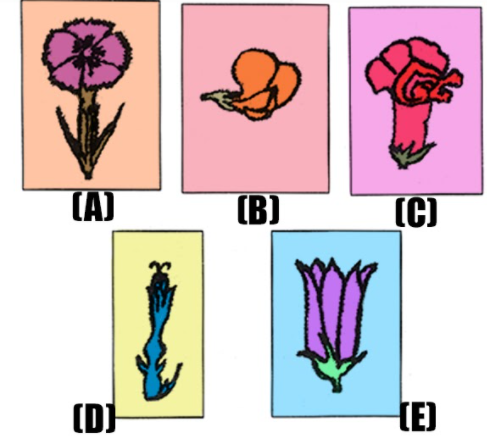
The correct sequence of types of corolla in the above figures is

(a) A – Caryophyllaceous, B – Papilionaceous, C – Bilabiate, D – Tubular, E – Bell-shaped
(b) A – Papilionaceous, B – Bilabiate, C – Tubular, D - Bell-shaped, E – Caryophyllaceous
(c) A - Bilabiate, B – Papilionaceous, C – Caryophyllaceous, D - Bell-shaped, E – Tubular
(d) A – Caryophyllaceous, B – Bilabiate, C – Papilionaceous, D - Tubular, E – Bell-shaped
(e) A – Tubular, B - Bell-shaped, C – Caryophyllaceous, D – Bilabiate, E - Papilionaceous

Answer
496.2k+ views
Hint: In Caryophyllaceae, the corolla is a pencil-cutter-like appearance, in Bilabiate, the corolla is a two-lipped appearance, in Papilionaceous, it is butterfly-like, in Tubular corolla it is tube-like and in Bell-shaped it is a bell-like shape in nature.
Complete answer:
Corolla is the second whorl of a flower composed of petals.
Caryophyllaceous – When five petals are clawed and have their limbs spreading outside. Example: Caryophyllaceae family members.
Papilionaceous – It is an irregular, polypetalous corolla with its five petals arranged so as to resemble a butterfly. It consists of a posterior largest vexillary, two lateral alae, and two anterior fused petals called a keel. Example: Papilionaceae family members.
Campanulate – They have bell-shaped corolla. Example: Campanulaceae family members.
Tubular – They are regular, gamopetalous corolla with their petals fused to form a tube, as in disc florets of Compositae. Example: Asteraceae family members.
Bilabiate – They are zygomorphic, gamopetalous corolla, in which petals are so fused together that they appear to be divided into two separate lips. So, they are also called blipped.
Additional information:
-The number of petals is usually the same as the number of sepals or may vary.
-Floral symmetry is defined mostly by the petals. When the petals of the corolla are of the same size and shape and they are equidistant from each other, then the flower has radial symmetry, and the flower is called actinomorphic. Also in regular flowers, any line drawn through the center will divide the flower into two identical halves. When at least one petal of the corolla is different, the flower has bilateral symmetry and it is called zygomorphic.
So, the correct answer is ‘A - Caryophyllaceous, B – Papilionaceous, C – Bilabiate, D – Tubular, E – Bell-shaped’.
Note:
-When the petals are free, the corolla is polypetalous and when the petals are fused, the corolla is gamopetalous.
-The corolla is the part of petals that are typically brightly coloured or white and attract insects and birds for pollination.
Complete answer:
Corolla is the second whorl of a flower composed of petals.
Caryophyllaceous – When five petals are clawed and have their limbs spreading outside. Example: Caryophyllaceae family members.
Papilionaceous – It is an irregular, polypetalous corolla with its five petals arranged so as to resemble a butterfly. It consists of a posterior largest vexillary, two lateral alae, and two anterior fused petals called a keel. Example: Papilionaceae family members.
Campanulate – They have bell-shaped corolla. Example: Campanulaceae family members.
Tubular – They are regular, gamopetalous corolla with their petals fused to form a tube, as in disc florets of Compositae. Example: Asteraceae family members.
Bilabiate – They are zygomorphic, gamopetalous corolla, in which petals are so fused together that they appear to be divided into two separate lips. So, they are also called blipped.
Additional information:
-The number of petals is usually the same as the number of sepals or may vary.
-Floral symmetry is defined mostly by the petals. When the petals of the corolla are of the same size and shape and they are equidistant from each other, then the flower has radial symmetry, and the flower is called actinomorphic. Also in regular flowers, any line drawn through the center will divide the flower into two identical halves. When at least one petal of the corolla is different, the flower has bilateral symmetry and it is called zygomorphic.
So, the correct answer is ‘A - Caryophyllaceous, B – Papilionaceous, C – Bilabiate, D – Tubular, E – Bell-shaped’.
Note:
-When the petals are free, the corolla is polypetalous and when the petals are fused, the corolla is gamopetalous.
-The corolla is the part of petals that are typically brightly coloured or white and attract insects and birds for pollination.
Recently Updated Pages
Why are manures considered better than fertilizers class 11 biology CBSE

Find the coordinates of the midpoint of the line segment class 11 maths CBSE

Distinguish between static friction limiting friction class 11 physics CBSE

The Chairman of the constituent Assembly was A Jawaharlal class 11 social science CBSE

The first National Commission on Labour NCL submitted class 11 social science CBSE

Number of all subshell of n + l 7 is A 4 B 5 C 6 D class 11 chemistry CBSE

Trending doubts
What is meant by exothermic and endothermic reactions class 11 chemistry CBSE

1 Quintal is equal to a 110 kg b 10 kg c 100kg d 1000 class 11 physics CBSE

What are Quantum numbers Explain the quantum number class 11 chemistry CBSE

What is periodicity class 11 chemistry CBSE

What is a periderm How does periderm formation take class 11 biology CBSE

Mention the basic forces in nature class 11 physics CBSE




